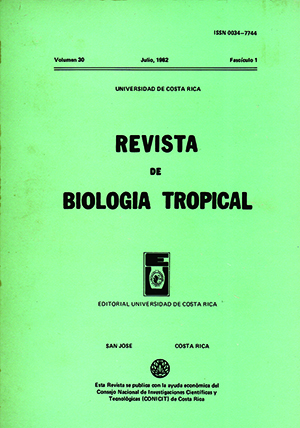Abstract
The introduced European house sparrow (Passer domesticus), presently expanding its New World range, invaded Costa Rica in 1974 or early 1975. Between 1980 and 1981 we studied the distribution of this species in Costa Rica, estimating the size of established populations and attempting to relate these factors to various ecological parameters. The house sparrow is now found practically throughout the country in settled areas, which are ecologically varied. Members of the species are almost always established at the center of towns, around parks and "plazas". There is a positive correlation between the size of the colonies and the human population density (r=0.63; p < 0.01) and a negative correlation between the house sparrow population densities and the annual rainfall (r=0.30; p < 0.05).References
Barrows, W.B. 1889. The English Sparrow in North America, especially in its rclations to agriculture. U.S. Dept. Agric. Div. of Economic Ornithology and Mammalogy. Bull. 1, 405 p.
Costa Rica. Dirección General de Estadística y Censos. 1979. Población de la República de Costa Rica por Provincias, Cantones y Distritos. Estimación al 10 de julio de 1979. No. 44. Ministerio de Economía, Industria y Comercio. San losé, Costa Rica.
De Schauensce, R.M. 1966. The species of birds of South America with their distribution. Livingston Publishing Co. Narberth. Penn., 422 p.
Dyer, M.I., J. Pinowski & B. Pinowska. 1977. Population Dynamies, p. 53-105. In Granivorou s Birds in Ecosystems. Cambridge University Press.
Bayes, R.O., L.C. Mamotte, & P. Holden. 1967. Ecology of arboviruses in Hale County, Texas, during 1965. Amer. J. Trop. Med. Hyg., 16: 675-687.
Holden, P., R.O. Hayes, C.J. Mitchell, J.S. Lazwiek, & T.B. Hughes. 1973a. House Sparrows, Passer domesticus as hosts of arboviruses in Hale County. Texas, I. Field Studies 1965-1969. Amer. J. Trop. Med. Hyg., 22, 244-253.
Holden, P., D.B. Franey, C.J. Mitchell, R.O. Hayes, J.S. Lazwiek, & T.B. Hughes. 1973b. House Sparrows, P. domesticus, as hosts of arboviruses in Hale County, Texas, II. Lab. Studies, ith Western equine enccphalitis virus. Amer. J. Trop. Med. Hyg., 22, 254-262.
Johnson, A.W. 1967. The birds of Chile and adjacent regions of Argentina, Bolivia and Peru. Volume II. Platt Establecimientos Gráficos. S.A. Buenos Aires,
Argentina. p. 341-342.
Johnston, R.F., & W.J. Klitz. 1977. Variation and evolution in a granivorous bird: the House Sparrow, p. 15-51. In Granivorous Birds in Ecosystems. International Biological Programme. Vol. 12. Cambridge Univ. Press.
Kendeigh, S.C. 1976. Latitudinal trends in the metabolic adjustment of the House Sparrow. Ecology 57, 509-519.
Kendeigh, S.C., & C.R. Blem. 1974. Metabolic adaptation to local elimate in birds. Comp. Biochem. Physiol., 48, 175-187.
Keve, A. 1965. Notes on the dífferent population of the House-Sparrow. Aquila, 71-72: 53-65.
Phelps, W.H., & R.M. De Schauensee. 1978. Una Guía para las aves de Venezuela. Princeton University Press, New Jersey. 484 p.
Ridgely, R.S. 1981. A guide to the birds of Panama. 3d Printing. Prineeton Univ. Press. Princeton, New Jersey. p. 367.
Robbins, C.S. 1973. lntroduction, spread and present abundance of the House Sparrow in North America. Ornithological Monographs No. 14. p. 3-9.
Smith, N.J. 1973. House Sparrows (Passer domesticus) in the Amazon. Candor, 75: 242-243.
Smith, N.J. 1980. Further advances of House Sparrows into the Brazilian Amazon. Condor, 82: 109-111.
Stiles, F.G., & S.M. Smith. 1980. Notes on bird distribution in Costa Rica. Brenesia, 17: 137-156.
Summers-Smith, D. 1959. The House Sparrow Passer domesticus: population problems. Ibis, 101: 449-454.
Thurber, W.A. 1972. House Sparrows in Guatemala. Auk, 89, 200.
##plugins.facebook.comentarios##

This work is licensed under a Creative Commons Attribution 4.0 International License.
Copyright (c) 1982 Revista de Biología Tropical


